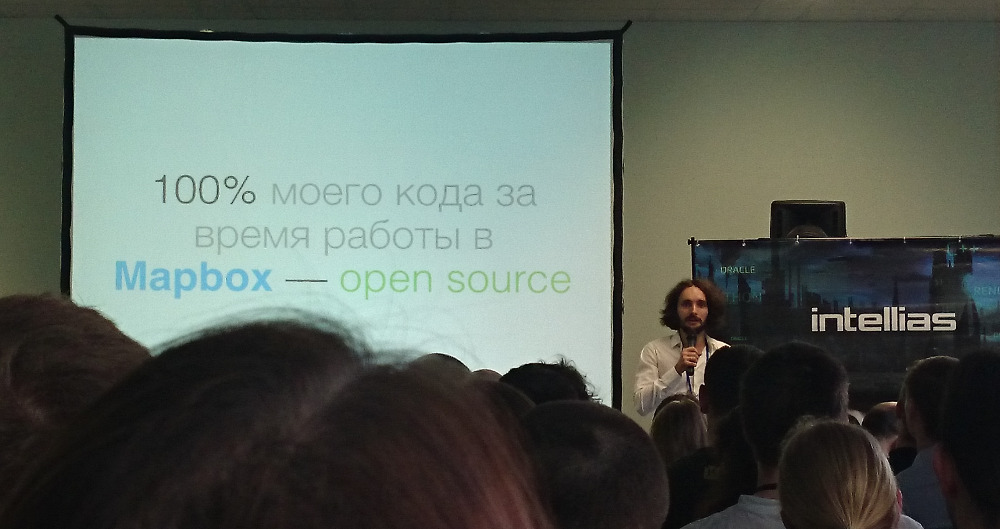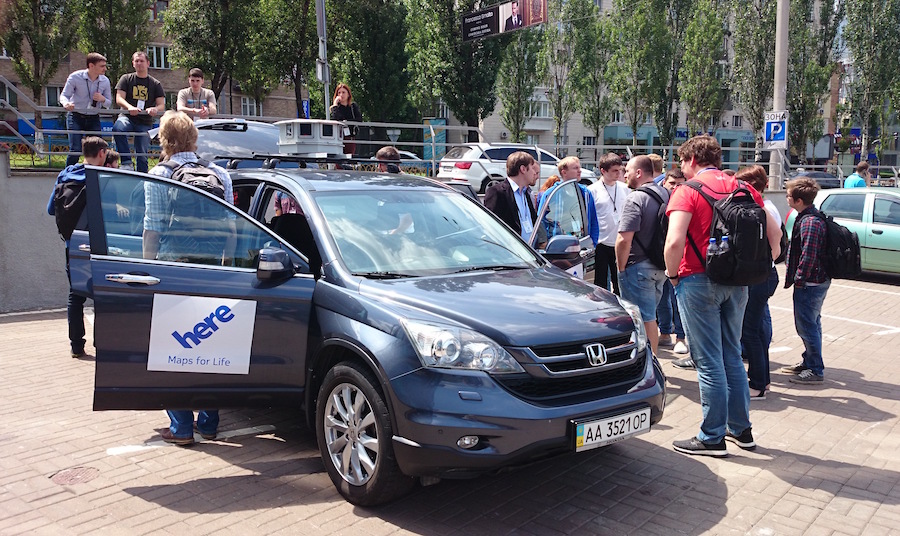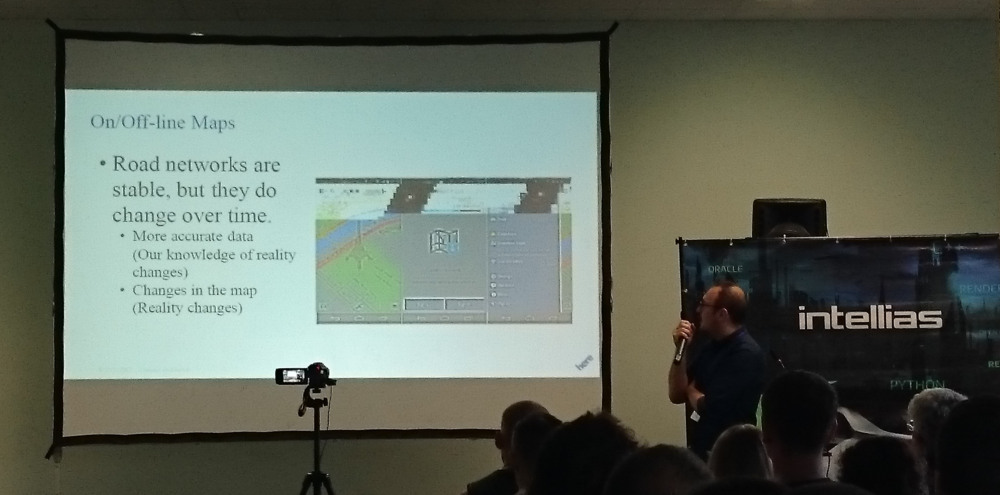Closed gestalt and a lot of meat at the Ukrainian Cartographic Conference

In early June, the Lviv-based Intellias company suddenly held a Map Solutions conference in Kiev. Without much promotion in Russian blogs, she gathered one and a half hundred Ukrainian developers and a dozen speakers from different countries. Plain empty business center, typical room, tea, coffee-cola - the recipe for the perfect conference. There are three official languages, and some speakers prepared to speak in English, but when they saw the participants live, listening to their perfect Russian language (with an interesting accent), they changed their mind. Reports and breaks were announced, however, all the same in three languages, and it looked surreal: as if you were really sitting at an international conference. I have not seen this before.
Cyril Dmitrenko, who spoke first from Yandex, has been working on panoramas for so long that he is already sick of some of the photos. He prepared a presentation in English - with such a small print that you had to strain. This is the scourge of techies: people, do not hesitate to write words in the whole wall . Cyril explained the theory of construction and display of panoramas. Initially, they wrote a rendering in Canvas 2D at Yandex: they cut a large photo into triangles, recalculated to screen coordinates, and drew. But here's the bad luck: Canvas is slow, especially in mobile devices and for some reason in Firefox. Sometimes the panorama was loaded for half a minute. But then WebGL arrived, rewrote everything on it, and complex calculations were not needed. We had to fight only with restrictions on the size of textures (4K - safely, then where as), but they decided to cut them into squares. The second half of the report was about the Yandex.Panor API, and a dozen questions "Can I do it the way I want?" Kirill had to answer: "No, just how we resolved, but we will think, thank you."
')
The hall was small, why it was packed, the speakers were decent, everything was audible. The presentations were recorded on camera and recently published photos and videos . The lecture of Viktor Shcherba from OsmAnd, perhaps, needs to be re-listened again: he reworked the report on creating cartoties from “Open GIS”, making a dense set of tips on every aspect - from the choice of colors and set of objects to the consistency and authoritarianism of the designer. In the beginning, he asked who does not know about OpenStreetMap: ten people raised their hands (including me). It was strange that with an abundance of words about the size and color in 20 minutes, Victor did not show a single illustration. Then screenshots, OsmAnd, paid updates and so on went. The first question from the floor was about monetization (very exciting), the last question is why Kiev was not signed on an overview scale.
Andrei Golovin from Mapbox began traditionally for Osmer - with a live broadcast of Show Me The Way . And then, in the context of Mapbox's interest in car navigation to lanes, he gave a master class on road tiling in OpenStreetMap. With an emphasis on drawing movement along the lanes: he even mentioned an ancient plugin for the visual creation of creepy relationships that experienced osmery had tried so hard to forget. JOSM was gathering on the screen, I occasionally lost the thread of the story, and I’m afraid to imagine what the uninitiated participants were like.
Vladimir Agafonkin continued the attack with incomprehensible terms and technologies of Mapbox. He no longer talks about Leaflet, instead he mentions vector tiles and a million libraries that help him work - turn vector data into them and vice versa - and quickly display the result in a browser. The leitmotif of his presentation was “but I didn’t find the right tools, so I wrote my own library that does it faster than others.” At the end of the next "his library" hall neighing. And I wrote down a single link that might come in handy: Protozero for quickly reading and writing the protobuf format.
Lunch. Meat, lots of meat and no queues. I love the organizers. At the table, talked with Alexander from Intellias. Geocoding on an industrial scale, everything is optimized: clouds, loading into memory, and the like. Our open source problems with the cracking of Nominatim cannot be understood by him. Intellias employees, the organizer of the conference, who had no reason to be ashamed of dissolving self-praise, and Intetics, a similar Kiev company, wandered around. Those and other outsourcers and work with cartography. Only Lviv has a large client with a cartographic project, thanks to which we all gathered.

Then we went down to the parking lot to watch the cartographers car Here. Once upon a time I found an article about Navteq cartographic crews, servers in the trunk, GPS inertial corrections and tablets on which a passenger notes everything he sees. This predetermined the passion for collecting data for OpenStreetMap from the car and sowed the dream to look at such a machine closer. Years went by, Nokia bought Navteq and renamed Here, then AutoConsortium bought Out Here. And so we met, where we were closer: cartographers put us to the passengers and drove along the block, explaining what and how they were drawing on the tablet and where they collected it goes later.

Everything is already familiar: two people per car, periodically changing places, 40–50 km per day in the city, outside the city, and 200. The exact track is going along, seven videos from seven cameras, sound from the microphone (albeit because of the matyuk decided to refuse it). Every day in the Atlas application they start a new project, into which the data is added; You can draw on top of the map, on the screen, hundreds of buttons about the quality and class of the road, fences, pits, traffic. The application is the same as ten years ago, written in Java, works under Win XP and adds the data to the Oracle database on the servers in the trunk. In Ukraine, cartographers with two cars collected all roads of the level of residential and higher, in some cities everything is altogether. True, “everything” in the context of Here is the road situation and addresses: they don’t have goals to make a POI catalog or to circle forests.
I missed Carlos's report from CartoDB, which was said to be very good, because of the trip, and ended up on Here again (their records were asked not to publish). Andrei Shnyr promised to talk about the incremental update of offline maps, and I was all in anticipation, because we begin to think about this topic in MAPS.ME. To the first question - who uses the Here navigation in the hall - a third of the participants raised their hands. I'm shocked. What do you mean why? Explaining the way to the pub after the conference, the organizer complained that the address does not make sense to look in the navigator, you still will not find. I did not believe it, entered the street and the house in MAPS.ME and immediately got a walking route to the desired point. The pub itself was not marked, but it’s not for nothing that we have the “Add place” button. I do not understand why all these people chew cactus here, just because of the advertising? I heard that the company plans to transport four hundred employees to Kiev, so it’s not surprising that they put PR on pressure.
Maria from the organizers of the conference especially asked to choose a technical topic that is applicable in practice, something interesting to programmers. It was evident that many speakers tried: if not about specific APIs, as in panoramas and Mapbox, so about algorithms and data structures, like me and Nikita. Andrew was the only one who was surprised by almost all of his report, devoting to the advertising of Here and its products. 30 gigabytes for the whole world! 200 layers! (What?) And here is a commercial for you (as usual, the player is plugged in). At the end - two slides: incremental updates are binary (a la diff / patch) and semantic (taking into account the format). Everything. However, I learned from the presentation about the universal format of NDS cards, which takes into account the possibility of updating. True, under it, it seems, they mean downloading of completely separate layers to separate regions.

Alex Gonopolsky continued the topic Here, talking about the very updates that everyone was waiting for. But since Here concentrates on the road network, they are interested in specific updates. Alex considered that only 1.6% of the road graph had changed in Berlin in 2013, and the nature of the changes was different: roads were built somewhere, speed limits changed somewhere, and in the data, in any case, this is considered a new segment. We are looking for the most optimal way to calculate and send changes to the road network to the user so that you do not have to download megabytes via GPRS.
Update maps are sent at the time of building the route on the server. The problem is the intersection and replacement of identifiers. Consistency at the boundaries of the updated data is also important, so that new roads do not end in a dead end. Solution: along with the route they send changes to the road graph, but only those that are not far from the route - nothing turns out to be total tiles (yes, the maps are divided into tiles of about 0.001 °, judging by the slides). And check that there are no dead ends on the borders of the tiles. Sometimes it may be cheaper not to update the map, but to build a detour using the old data.

Nikita Platonenko works in a company with an ambiguous name FamilyInSafe . Something about communication within the family and automatic check-ins with a group of frequently visited places. So the whole report is about clustering algorithms, both “bicycle” and popular DBSCAN with mention of k-means. Unexpectedly, informatively and technically, I even understood how clustering works: we simply draw an imaginary circle around each point and combine the intersecting ones. But before that, he considered it as magic, for which it is better to find a library and not to bother. But Nikita has no such option: he works not with Leaflet , but with Google Maps and Google Places.
I spoke my report very quickly, because instead of 40 minutes, like all of the above, I took 20. I told about the formats of data compression OpenStreetMap and interesting algorithmic finds inside them. Missed deadline made it possible not to answer a hundred questions about MAPS.ME - now I understand that it’s in vain.
The presentation of Sergey Shelkovnikov from GISFile was too abstract. Storage of geodata is a very specific topic: give the task, get the formats and applications. But Sergey very long explained some basic things, like the difference between the main and additional layers and loading them into the database. I was waiting for OSM rhymes, but in the context of the report it was mentioned no more than as tiles for the background. “It is possible, it is possible, it is possible”: there is little concrete, an excess of vague advice.
In OpenStreetMap, we roughly represent the cartographic side of indoor navigation, while Vladislav Ivanov from QROK talked about the technical side . He is engaged in beacons: boxes with iBeacon (work on BLE) and Wi-Fi. Receivers still seem to use accelerometers. I liked that the lighthouses are made in Odessa. To navigate, three lighthouses are enough; more is better, but when there are 15 of them, they start interfering with each other and the system goes crazy. Yes, more reflections: on the street with GPS, it is enough to move away from the wall of the building, but inside some of the walls and ceilings. The problem of reflections was decided elegantly: they made up the base of the readings of the receivers for all points of the room with a step of two meters and did not calculate the position, but simply looked at the table. The complexity of adding a new lighthouse is not clear, or how reducing their power will affect the positioning accuracy.
After placing the beacons and measuring the signals, you need a map for the application to see where the store is and to make routes. It is also important to note dead zones, such as utility rooms and toilets. Andrei Petrov told about the drawing of rooms in OSM in detail at the last “Circuit Designer”, Here there is a large collection of shopping centers, but QROK started a partnership with Google Maps. And it seems that they have to draw charts for TRK on their own. Accuracy of reception is 1–5 meters, the beacons from the battery work for two years, but just in case they are checked more often: if the battery is dead, the beacon can not be found is too small. They want to solve this trouble by embedding beacons in the power grid - for example, in lighting. From the answers I also learned that location determination via Wi-Fi only works on Android, there are no rights on iOS.
The conference ended, among those who posted photos on Facebook, played a watch from TomTom, choosing a winner using random.org . Then "shmatochek information" about the pub, and all fled. Sending people around the sidewalk, I checked the direct walking route from MAPS.ME - made my way along the path through the bushes and descended an abandoned staircase, from where I went straight to the right street. The waiters in the pub were horrified by the number of people: they were not warned, and all orders were prepared by a single cook. We sat long enough to wait for him, but for some reason in groups: osmery, programmers, bloggers, organizers, employees Here. The beer was spread quickly, the conversation went on, for the evening, they caught up with the developers of OsmAnd with tea at Shokoladnitsa and went home.

Ukraine rarely appears in geo-information news. I was able to recall only the “GIS-forum”, which was held in March in Kharkov, and a couple of initiatives by Oleg Seliverstova about reserves. At the same time, there are a lot of developers, a lot of orders for cartography, indoor is developing, all Mapbox employees in Eastern Europe live in Ukraine, and Here, again, they are looking at the country. For half a year Ukrainians have been doing a modern bilingual blog 50 North about cartographic news - a sign of a growing community. The Map Solutions conference is important not only because it united people interested in cartographic technologies from different countries for a day - this is one of the ways to attract new people to cartography and grow their own neo-cartographic industry. We at OpenStreetMap can use these events to educate people and attract them to open technology and geodata. The main thing is to participate more often.
Source: https://habr.com/ru/post/303928/
All Articles